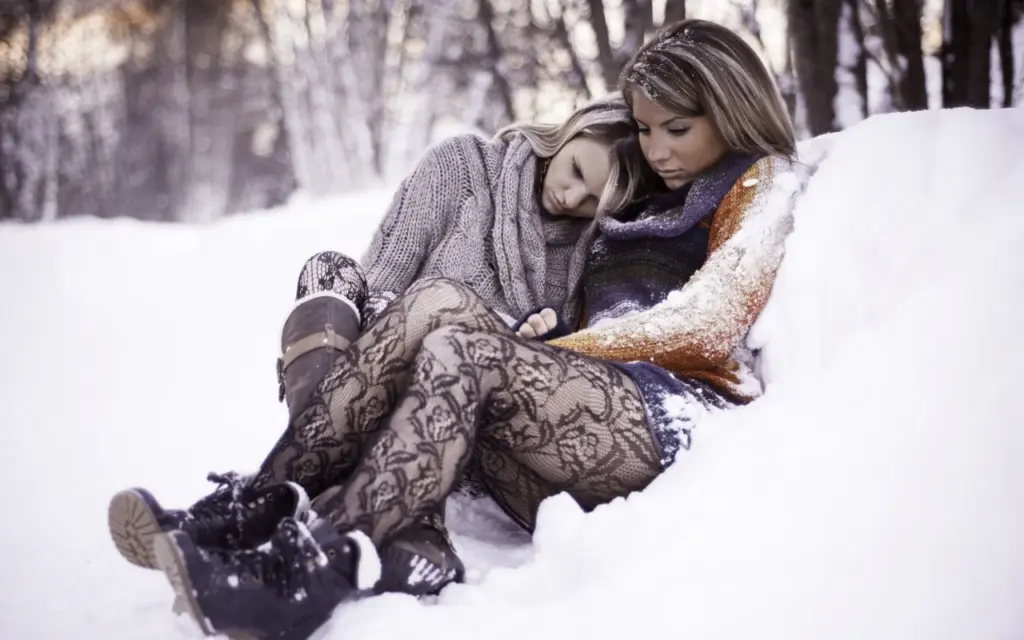As autumn arrives and temperatures plummet across the Arctic archipelago of Svalbard, fashion takes on an entirely different meaning than anywhere else in the world. Here, 1,200 kilometers from the North Pole, style isn’t just about looking good—it’s about survival, comfort, and maintaining femininity in one of Earth’s most extreme environments.
A Tapestry of Cultures: The Women of Svalbard
The women of Svalbard represent a fascinating multicultural community that defies Arctic stereotypes. According to recent demographic data, while Norwegians comprise 61.1% of the population, the remaining 38.9% creates a rich international tapestry that significantly influences local fashion culture.
Among foreign residents, women make up 51% of the international community, with particularly notable representation from Thailand (comprising one-third of foreign female residents), Sweden, the Philippines, and Ukraine. This diverse mix creates a unique fusion of fashion sensibilities—from Scandinavian minimalism to Southeast Asian color preferences, all adapted to the unforgiving Arctic climate.
The Russian community in Barentsburg adds another layer to this multicultural fashion landscape, with Ukrainian women making up 80% of that settlement’s population. Each cultural group brings its own approach to staying warm while maintaining personal style, creating a distinctly cosmopolitan Arctic fashion scene.
The Great Pantyhose Revelation: An Arctic Necessity
Perhaps nowhere is the adaptation to Arctic life more evident—and amusing—than in what locals jokingly call the “Svalbard pantyhose phenomenon.” A friend who lives in Longyearbyen recently shared a delightful insight:
thermal pantyhose and tights are virtually mandatory for women in Svalbard, even during the brief summer months when temperatures hover around 3-7°C.
This isn’t mere fashion preference—it’s practical necessity wrapped in feminine sensibility. When your “summer” temperatures barely reach what most consider ideal air conditioning, maintaining both warmth and style requires creative solutions. Local women have discovered that high-quality thermal tights serve as the perfect base layer, allowing them to wear dresses and skirts year-round while staying comfortable.
The tax-free shopping situation in Svalbard means that high-end thermal hosiery, fleece-lined tights, and specialized Arctic pantyhose are more accessible than in mainland Norway. Brands offering thermal tights rated for temperatures from 0°C to -15°C (32°F to 5°F) have become wardrobe staples, with many women maintaining collections in various weights and deniers for different weather conditions.
Local shops report that thermal tights and pantyhose are among their most consistent sellers, regardless of season. The combination of practicality and the desire to maintain feminine style has made quality thermal hosiery an essential element of Svalbard’s women’s fashion ecosystem.
Layering as an Art Form
In Svalbard, the layering system becomes far more sophisticated than anywhere else in the world. Women here have perfected the art of building outfits that can transition from -25°C outdoor conditions to +20°C indoor environments within minutes.
The base layer typically consists of merino wool or synthetic thermal underwear, followed by the essential thermal tights or pantyhose. The middle layer might include wool sweaters, fleece jackets, or insulated garments, all chosen not just for warmth but for how they complement each other aesthetically.
The outer shell represents where personal style truly shines. Arctic-rated winter jackets have evolved far beyond purely functional gear. Modern Arctic fashion includes stylish parkas with flattering cuts, sophisticated color palettes, and details that allow women to express personality even while bundled for survival.
The Shopping Scene: Tax-Free Arctic Fashion
Svalbard’s tax-free status creates a unique shopping environment where high-quality Arctic fashion becomes more accessible. Local shops like Svalbardbutikken (the world’s northernmost department store) and specialized outdoor retailers like Spitsbergen Sport and Arctica offer carefully curated selections of women’s clothing designed for extreme conditions.
The shopping experience reflects the community’s international character. You’ll find Scandinavian design aesthetics alongside practical Russian winter wear influences and touches of Southeast Asian color preferences adapted for Arctic conditions. Local boutiques stock everything from Norwegian wool sweaters to specialized thermal fashion pieces designed specifically for polar conditions.
Women’s clothing stores report consistent demand for items that many southern locations would consider purely winter specialties: insulated dresses, thermal-lined skirts, fashionable snow pants, and an extensive range of thermal undergarments that allow women to maintain their preferred style regardless of temperature.
Cultural Fusion in Arctic Fashion
The multicultural nature of Svalbard’s female population creates fascinating fashion fusion. Norwegian women contribute practical minimalism and high-quality wool traditions. Thai women often introduce brighter colors and decorative elements, adapted for Arctic conditions. Swedish and other Scandinavian influences bring contemporary design sensibilities, while Eastern European residents contribute expertise in layering techniques perfected in harsh continental winters.
This cultural exchange happens naturally in the small community setting. Fashion advice flows freely among neighbors from different continents, creating hybrid approaches to Arctic dressing that wouldn’t exist anywhere else. A Filipino woman might learn about Icelandic wool from a Norwegian neighbor, while sharing insights about maintaining jewelry and accessories in extreme cold.
The result is a distinctive Svalbard style that combines the best practical elements from various cold-weather traditions while maintaining individual cultural touches and personal expression.
Summer Style: Redefining Warm Weather Fashion
Svalbard’s summer presents unique fashion challenges that highlight the community’s adaptive creativity. When “summer” temperatures average 3-7°C, traditional warm-weather clothing simply doesn’t apply. Instead, women have developed a sophisticated summer style based on lighter layers rather than bare skin.
Summer fashion in Svalbard typically features lighter thermal tights (rather than the heavy-duty winter versions), fashionable waterproof boots, stylish rain jackets that double as wind protection, and accessories that can be quickly added or removed as conditions change. Dresses and skirts remain popular, but they’re consistently paired with thermal tights and layers that can be adjusted throughout the day.
The midnight sun season allows for extended outdoor activities, making versatile fashion choices essential. Women need outfits that work for hiking glaciers in the afternoon and dining at nice restaurants in the evening—often without the luxury of going home to change.
Footwear Fashion: Function Meets Style
Perhaps no fashion category faces greater challenges in Svalbard than footwear. The famous local custom of removing shoes when entering any building (a tradition dating to coal mining days) means women need attractive indoor alternatives alongside their essential Arctic boots.
Many women maintain extensive footwear collections including insulated winter boots for extreme conditions, waterproof hiking boots for summer excursions, lighter indoor shoes for office settings, and elegant slippers for social occasions. The tax-free shopping situation makes investing in high-quality, specialized footwear more feasible than in most Arctic locations.
Local fashion has adapted to accommodate this footwear flexibility. Outfits are planned knowing that Arctic boots will be removed frequently, so careful attention is paid to how thermal tights and socks look when boots come off. This consideration influences everything from the choice of tights patterns to the selection of indoor footwear that complements overall outfits.
Beauty and Accessories in Extreme Conditions
Maintaining beauty routines and accessory preferences in Svalbard requires special considerations. The extreme dryness of Arctic air demands intensive skincare routines, with local shops stocking specialized Arctic beauty products and moisturizers designed for polar conditions.
Jewelry requires special consideration—metal accessories can become uncomfortably cold against skin, leading many women to prefer layered clothing accessories or pieces that remain covered by thermal layers. Scarves, decorative gloves, and stylish hats become primary accessory categories, allowing for personal expression while serving functional purposes.
Hair care adapts to constant hat-wearing and extreme temperature changes. Many women develop styling routines that accommodate frequent covering and uncovering of hair, often favoring styles that look good after being under winter hats for extended periods.
Social Fashion: Community Events and Style
Despite the isolation and extreme conditions, Svalbard maintains an active social calendar that provides opportunities for fashion expression. From the Polar Jazz Festival in February to the Sun Festival in March, community events create occasions for women to showcase style beyond purely functional considerations.
These events reveal how the international community influences local fashion culture. You might see Norwegian minimalism combined with Filipino color sensibilities, Russian layering expertise paired with Thai decorative touches, all adapted for Arctic social settings.
The small community size means fashion choices are highly visible, encouraging creativity and personal expression while maintaining the practical necessities of Arctic living. Women often become known for signature styles that work within Arctic constraints while reflecting their cultural backgrounds and personal preferences.
Seasonal Transitions: Adapting Style Through Polar Extremes
Living through Svalbard’s extreme seasonal variations requires fashion flexibility unknown anywhere else. The transition from polar night (mid-October to mid-February) to midnight sun (mid-May to mid-August) demands completely different approaches to dressing, both practically and psychologically.
During polar night, when temperatures can drop to -25°C (-13°F) or lower, fashion becomes about maintaining morale and personal identity through months of darkness. Bright colors take on special importance, quality fabrics become essential for psychological comfort, and careful attention to personal style helps combat the isolation that extreme conditions can create.
The midnight sun season allows for lighter layers but presents different challenges—UV protection becomes crucial with 24-hour daylight reflecting off snow and ice, while maintaining style flexibility for extended outdoor activities during the endless daylight hours.
The Future of Arctic Fashion
As climate change affects Svalbard more dramatically than almost anywhere else on Earth, local fashion is evolving too. Women report needing more transitional pieces as temperature swings become more extreme and unpredictable. The traditional Arctic wardrobe based on consistent extreme cold is adapting to include more versatile pieces for increasingly variable conditions.
The international community continues to grow, bringing new cultural influences to local fashion. Recent arrivals from different continents contribute fresh perspectives on cold-weather dressing, often combining techniques from their home countries with Arctic necessities in innovative ways.
Technology influences Arctic fashion as new materials and design innovations make it possible to stay warm with less bulk, allowing for more fashion-forward approaches to extreme weather dressing. Smart fabrics, improved insulation techniques, and better understanding of layering systems continue to expand possibilities for style in the Arctic.
Living Style in the World’s Edge
The women of Svalbard have created something unique in the fashion world—a style culture that successfully combines practical necessity with personal expression, international influences with local adaptation, and traditional techniques with modern innovation. From the essential thermal pantyhose that keep legs warm under summer dresses to the sophisticated layering systems that allow for style flexibility in -25°C weather, Svalbard women have proven that fashion and function can successfully coexist even at the edge of the habitable world.
Their approach to Arctic fashion offers lessons that extend far beyond the polar regions—demonstrating how creativity, community, and cultural exchange can transform even the most challenging circumstances into opportunities for personal expression and shared innovation.
In Svalbard, fashion isn’t just about looking good—it’s about maintaining humanity, expressing cultural identity, and building community in one of Earth’s most extreme environments. And yes, it almost always involves really good thermal tights.


